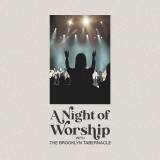Story Behind The Heart of Worship (Matt Redman)
Author: Matt Redman
 In the popular Pixar film Findinq Nemo (about a clownfish on a
search across the ocean for his only son) there is a scene that might
help us understand some style aspects of worship. The usually reserved
father-fish, Marlin, and his amnesic acquaintance, Dory, find themselves
distracted from searching for Nemo by a glowing orb of light in a deep,
dark part of the ocean. You may recall the two characters chasing the
light, toying with it and even trying to grab it; however, the light
soon intensifies just enough for the audience to discover that it is
actually a lure. It’s a trick designed to bring the two enamored
protagonists into close proximity with the gigantic fangs of an
anglerfish.
In the popular Pixar film Findinq Nemo (about a clownfish on a
search across the ocean for his only son) there is a scene that might
help us understand some style aspects of worship. The usually reserved
father-fish, Marlin, and his amnesic acquaintance, Dory, find themselves
distracted from searching for Nemo by a glowing orb of light in a deep,
dark part of the ocean. You may recall the two characters chasing the
light, toying with it and even trying to grab it; however, the light
soon intensifies just enough for the audience to discover that it is
actually a lure. It’s a trick designed to bring the two enamored
protagonists into close proximity with the gigantic fangs of an
anglerfish.
“The pastor of our church, Mike, did a brave thing,” Redman recalls, “we stopped using the PA and projectors, packed away our instruments for a while and gathered in an adjoining room with nothing but our voices and Bibles—and, of course, our hearts. This led us into a whole new season. We stripped away anything associated with style, preference, or performance, and there was a real sense of discovering ‘the heart of worship’ again.”
His song, “The Heart of Worship,” describes what happened:
When the music fades,
All is stripped away.
And I simply come;
Longing just to bring
something that’s of worth,
That will bless Your heart.
Redman continues. “It was a song written out of witnessing what God was doing with our worshiping community. As a church family we’d always given lots of time to responding to God through song. However, we’d lost something of the sense of bringing an offering.” Instead, a sense of consumerism had seeped in. Songs and style and personal volume preferences and so on had crept far too high up the ladder—we’d lost the dynamic of worship being ‘the all-consuming response to the all-deserving revelation of God.’”
In his book The Unquenchable Worshipper, Redman writes, “After a while, the worship band and the sound system reappeared, but now it was different. The songs of our hearts had caught up with the songs of our lips.”
“I think I became dependent on too many outward things.” Redman says about the time period in which he penned “Heart of Worship.” “In my mind I’d be so excited if I had a good band, and the sound was great—falling for the old trick of thinking that those things automatically equated with good worship.
“It was also a well-timed lesson for me personally. We were in a season where a few folks around the world were encouraging me about my songs—saying they (along with lots of other peoples’) were bringing a fresh style. To have a reminder at the local church level that style and sound were not central was a brilliantly timed lesson for my soul.”
“I love it when I find myself in a totally different environment, in terms of expressions of worship. Wholehearted gathered worship, but worship in a style alien to the way I usually express myself. I always find it a great test of the heart to see if I will throw myself into it—regardless of the style.”
“Take time out.” Redman concludes, “Take a few steps back and try to focus in on what is essential. Remember whom worship is for. Remind yourself about the value of servanthood. Recall that unity in diversity may be one of the key things that set us apart from the world’s ways of doing things. Before long we’ll have a new perspective and be ready to talk honestly and passionately with all relevant parties— to pursue finding a healthy way ahead.”
Often the story behind a song is as transforming, intriguing and richly meaningful as the song itself.
Source: Worship Leader

Siren Songs
Worship leaders, given the task of finding the heart of the Father may, unfortunately, discover similar orbs of light while traversing the enigmatic ocean of worship. One of the most common lures is an over-focus on style. And like the light of the anglerfish, that temptation has a certain ability to grab the attention of everyone who sees (or hears). Matt Redman was one of the first to admit the danger of getting caught up in the quality of sound—the desire to be pleasing to more than simply the ear of God. A few years back, his church was on the forefront of modern worship, but the pastor sensed that in all the excellence of craft, there was a heart of praise missing from their gathered worship.“The pastor of our church, Mike, did a brave thing,” Redman recalls, “we stopped using the PA and projectors, packed away our instruments for a while and gathered in an adjoining room with nothing but our voices and Bibles—and, of course, our hearts. This led us into a whole new season. We stripped away anything associated with style, preference, or performance, and there was a real sense of discovering ‘the heart of worship’ again.”
His song, “The Heart of Worship,” describes what happened:
When the music fades,
All is stripped away.
And I simply come;
Longing just to bring
something that’s of worth,
That will bless Your heart.
Redman continues. “It was a song written out of witnessing what God was doing with our worshiping community. As a church family we’d always given lots of time to responding to God through song. However, we’d lost something of the sense of bringing an offering.” Instead, a sense of consumerism had seeped in. Songs and style and personal volume preferences and so on had crept far too high up the ladder—we’d lost the dynamic of worship being ‘the all-consuming response to the all-deserving revelation of God.’”
In his book The Unquenchable Worshipper, Redman writes, “After a while, the worship band and the sound system reappeared, but now it was different. The songs of our hearts had caught up with the songs of our lips.”
Leading Lesson
As well as taking part in the Soul Survivor movement, writing numerous books on the subject of worship, perennially being at the top of the CCLI charts and continuing to put forth devotional art that reaches across the world, Matt Redman is a groundbreaker and leader of modern Christian worship. But, progressive thought and art can also have its obstacles.“I think I became dependent on too many outward things.” Redman says about the time period in which he penned “Heart of Worship.” “In my mind I’d be so excited if I had a good band, and the sound was great—falling for the old trick of thinking that those things automatically equated with good worship.
“It was also a well-timed lesson for me personally. We were in a season where a few folks around the world were encouraging me about my songs—saying they (along with lots of other peoples’) were bringing a fresh style. To have a reminder at the local church level that style and sound were not central was a brilliantly timed lesson for my soul.”
Windows to Doors
It is a lesson that all worship leaders must continually learn and re-learn. However, there is a place for style. And sound quality plays an important role in churches that are becoming accustomed to a “musically relevant” praise. Redman says, “Style is important because it’s a window to the world—people look in on us and assess where the worshiping church is in terms of relevance to their lives. If we get it right, it might go beyond serving merely as a ‘window’ and become a ‘doorway.’ But it is also important because it helps generations and cultures voice their gathered worship in an unhindered fashion. Of course, it becomes unhealthy if we lean on that particular voicing too hard. In other words, only being able to worship if that voicing/style is present. ‘Not I,’ we might say, but it’s all too easy for this to happen. Especially after worshiping together in one specific way or musical style for many decades.“I love it when I find myself in a totally different environment, in terms of expressions of worship. Wholehearted gathered worship, but worship in a style alien to the way I usually express myself. I always find it a great test of the heart to see if I will throw myself into it—regardless of the style.”
The Glowing Orb
It is a good lesson and a good challenge. Worship leaders are given the task of balance, but that balance must be understood and brought to the global—and local—Church through the primary purpose of adoration, awe, reverence and submission to God—what he wants as opposed to what we want. Often, the thing we want is like the glowing orb of the anglerfish in Finding Nemo, designed to distract us from our purpose in worship.“Take time out.” Redman concludes, “Take a few steps back and try to focus in on what is essential. Remember whom worship is for. Remind yourself about the value of servanthood. Recall that unity in diversity may be one of the key things that set us apart from the world’s ways of doing things. Before long we’ll have a new perspective and be ready to talk honestly and passionately with all relevant parties— to pursue finding a healthy way ahead.”
Often the story behind a song is as transforming, intriguing and richly meaningful as the song itself.
Source: Worship Leader
Story Behind The Heart of Worship (Matt Redman)
 Reviewed by Admin
on
8:00:00 PM
Rating:
Reviewed by Admin
on
8:00:00 PM
Rating:
 Reviewed by Admin
on
8:00:00 PM
Rating:
Reviewed by Admin
on
8:00:00 PM
Rating:
















Awesome
ReplyDelete